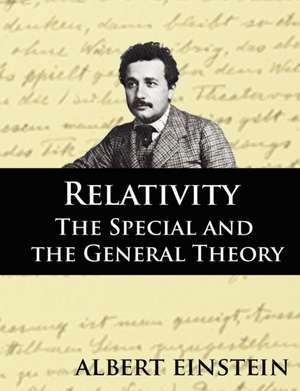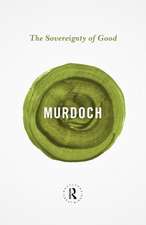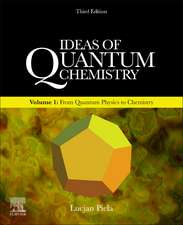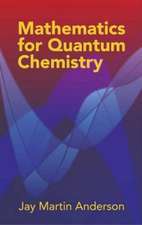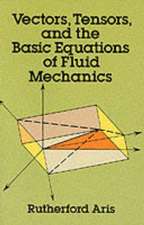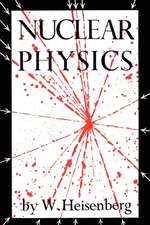Relativity
Autor Albert Einsteinen Limba Engleză Paperback – 7 sep 2007
According to Einstein himself, this book is intended "to give an exact insight into the theory of Relativity to those readers who, from a general scientific and philosophical point of view, are interested in the theory, but who are not conversant with the mathematical apparatus of theoretical physics." When he wrote the book in 1916, Einstein's name was scarcely known outside the physics institutes. Having just completed his masterpiece, "The General Theory of Relativity" -- which provided a brand-new theory of gravity and promised a new perspective on the cosmos as a whole -- he set out at once to share his excitement with as wide a public as possible in this popular and accessible book.
Preț: 70.07 lei
Nou
Puncte Express: 105
Preț estimativ în valută:
13.41€ • 14.57$ • 11.27£
13.41€ • 14.57$ • 11.27£
Carte disponibilă
Livrare economică 01-15 aprilie
Preluare comenzi: 021 569.72.76
Specificații
ISBN-13: 9789569569067
ISBN-10: 9569569069
Pagini: 96
Dimensiuni: 189 x 246 x 5 mm
Greutate: 0.19 kg
Editura: www.bnpublishing.com
Locul publicării:Chile
ISBN-10: 9569569069
Pagini: 96
Dimensiuni: 189 x 246 x 5 mm
Greutate: 0.19 kg
Editura: www.bnpublishing.com
Locul publicării:Chile
Descriere
The Nobel Prize-winning scientist's presentation of his landmark theory
According to Einstein himself, this book is intended "to give an exact insight into the theory of Relativity to those readers who, from a general scientific and philosophical point of view, are interested in the theory, but who are not conversant with the mathematical apparatus of theoretical physics." When he wrote the book in 1916, Einstein's name was scarcely known outside the physics institutes. Having just completed his masterpiece, "The General Theory of Relativity" -- which provided a brand-new theory of gravity and promised a new perspective on the cosmos as a whole -- he set out at once to share his excitement with as wide a public as possible in this popular and accessible book.
According to Einstein himself, this book is intended "to give an exact insight into the theory of Relativity to those readers who, from a general scientific and philosophical point of view, are interested in the theory, but who are not conversant with the mathematical apparatus of theoretical physics." When he wrote the book in 1916, Einstein's name was scarcely known outside the physics institutes. Having just completed his masterpiece, "The General Theory of Relativity" -- which provided a brand-new theory of gravity and promised a new perspective on the cosmos as a whole -- he set out at once to share his excitement with as wide a public as possible in this popular and accessible book.
Notă biografică
Albert Einstein (14 March 1879 - 18 April 1955) was a German-born theoretical physicist[5] who developed the theory of relativity, one of the two pillars of modern physics (alongside quantum mechanics).[3][6]:274 His work is also known for its influence on the philosophy of science.[7][8] He is best known to the general public for his mass-energy equivalence formula E = mc2, which has been dubbed "the world's most famous equation".[9] He received the 1921 Nobel Prize in Physics "for his services to theoretical physics, and especially for his discovery of the law of the photoelectric effect",[10] a pivotal step in the development of quantum theory. The son of a salesman who later operated an electrochemical factory, Einstein was born in the German Empire but moved to Switzerland in 1895 and renounced his German citizenship in 1896.[5] Specializing in physics and mathematics, he received his academic teaching diploma from the Swiss Federal Polytechnic School (German: eidgenössische polytechnische Schule, later ETH) in Zürich in 1900. The following year, he acquired Swiss citizenship, which he kept for his entire life. After initially struggling to find work, from 1902 to 1909 he was employed as a patent examiner at the Swiss Patent Office in Bern. Near the beginning of his career, Einstein thought that Newtonian mechanics was no longer enough to reconcile the laws of classical mechanics with the laws of the electromagnetic field. This led him to develop his special theory of relativity during his time at the Swiss Patent Office. In 1905, called his annus mirabilis (miracle year), he published four groundbreaking papers, which attracted the attention of the academic world; the first outlined the theory of the photoelectric effect, the second paper explained Brownian motion, the third paper introduced special relativity, and the fourth mass-energy equivalence. That year, at the age of 26, he was awarded a PhD by the University of Zurich. Although initially treated with skepticism from many in the scientific community, Einstein's works gradually came to be recognised as significant advancements. He was invited to teach theoretical physics at the University of Bern in 1908 and the following year moved to the University of Zurich, then in 1911 to Charles University in Prague before returning to the Federal Polytechnic School in Zürich in 1912. In 1914, he was elected to the Prussian Academy of Sciences in Berlin, where he remained for 19 years. Soon after publishing his work on special relativity, Einstein began working to extend the theory to gravitational fields; he then published a paper on general relativity in 1916, introducing his theory of gravitation. He continued to deal with problems of statistical mechanics and quantum theory, which led to his explanations of particle theory and the motion of molecules. He also investigated the thermal properties of light and the quantum theory of radiation, the basis of laser, which laid the foundation of the photon theory of light. In 1917, he applied the general theory of relativity to model the structure of the universe
Cuprins
Foreword to the Routledge Great Minds Edition Preface PART I: The Special Theory of Relativity 1. Physical Meaning of Geometrical Propositions 2. The System of Co-ordinates 3. Space and Time in Classical Mechanics 4. The Galileian System of Co-ordinates 5. The Principle of Relativity (in the Restricted Sense) 6. The Theorem of the Addition of Velocities Employed in Classical Mechanics 7. The Apparent Incompatibility of the Law of Propagation of Light with the Principle of Relativity 8. On the Idea of Time in Physics 9. The Relativity of Simultaneity 10. On the Relativity of the Conception of Distance 11. The Lorentz Transformation 12. The Behaviour of Measuring-Rods and Clocks in Motion 13. Theorem of the Addition of Velocities. The Experiment of Fizeau 14. The Heuristic Value of the Theory of Relativity 15. General Results of the Theory 16. Experience and the Special Theory of Relativity 17. Minkowski’s Four-dimensional Space PART II: The General Theory of Relativity 18. Special and General Principle of Relativity 19. The Gravitational Field 20. The Equality of Inertial and Gravitational Mass as an Argument for the General Postulate of Relativity 21. In what Respects are the Foundations of Classical Mechanics and of the SpecialTheory of Relativity Unsatisfactory? 22. A Few Inferences from the General Principle of Relativity 23. Behaviour of Clocks and Measuring-Rods on a Rotating Body of Reference 24. Euclidean and non-Euclidean Continuum 25. Gaussian Co-ordinates 26. The Space-Time Continuum of the Special Theory of Relativity Considered as a Euclidean Continuum 27. The Space-Time Continuum of the General Theory of Relativity is not a Euclidean Continuum 28. Exact Formulation of the General Principle of Relativity 29. The Solution of the Problem of Gravitation on the Basis of the General Principle of Relativity PART III: Considerations on the Universe as a Whole 30. Cosmological Difficulties of Newton's Theory 31. The Possibility of a "Finite" and yet "Unbounded" Universe 32. The Structure of Space according to the General Theory of Relativity APPENDICES: 1. Simple Derivation of the Lorentz Transformation [Supplementary to Section 11] 2. Minkowski’s Four-dimensional Space ("World") [Supplementary to Section 17] 3. The Experimental Confirmation of the General Theory of Relativity (a) Motion of the Perihelion of Mercury (b) Deflection of Light by a Gravitational Field (c) Displacement of Spectral Lines towards the Red 4 The Structure of Space according to the General Theory of Relativity [Supplementary to Section 32] 5. Relativity and the Problem of Space Bibliography Index
Recenzii
'He was unfathomably profound - the genius among geniuses who discovered, merely by thinking about it, that the universe was not as it seemed.' - Time
'Much of the book is a delight.' - Stephen Battersby, New Scientist
'[Einstein] is a far better populariser of science than Stephen Hawking ... you'll feel as though you have a ringside seat at a revolution in human understanding.' - Guardian
'Much of the book is a delight.' - Stephen Battersby, New Scientist
'[Einstein] is a far better populariser of science than Stephen Hawking ... you'll feel as though you have a ringside seat at a revolution in human understanding.' - Guardian
